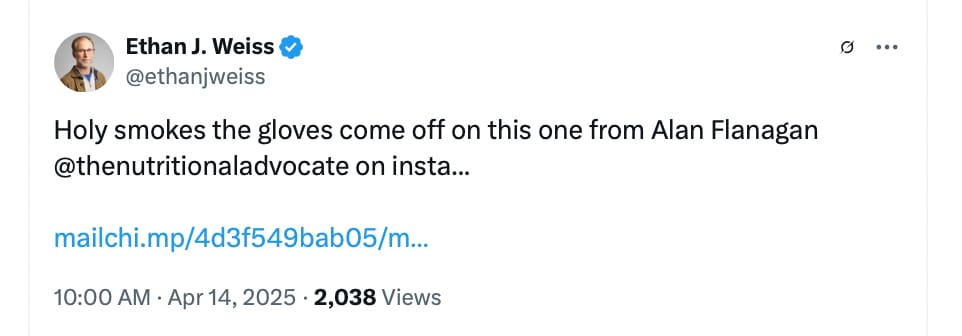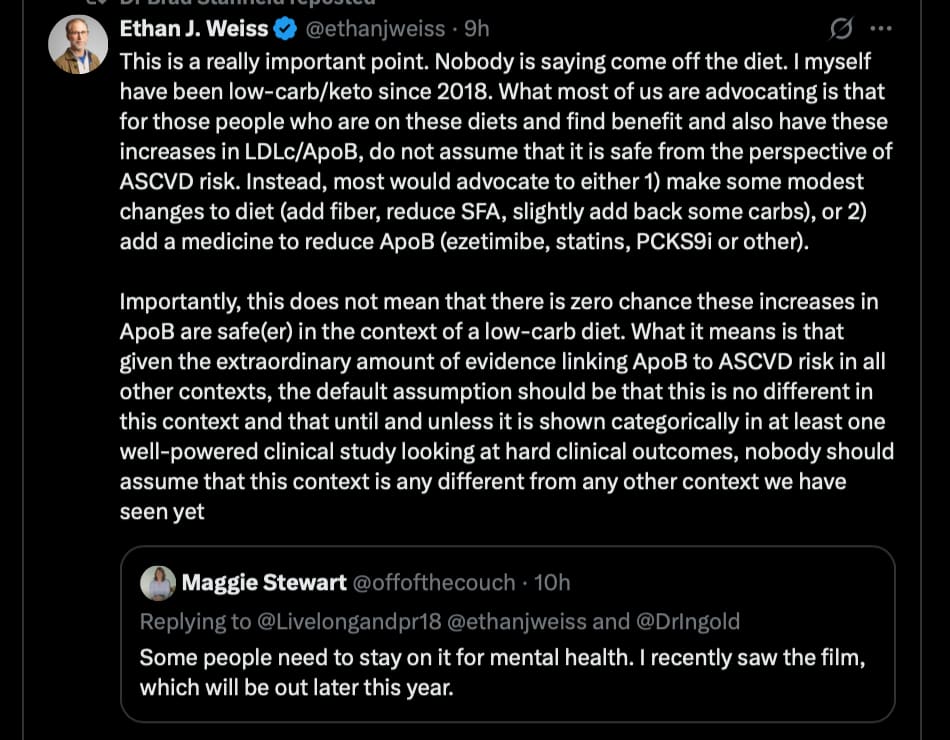Not sure where to put this post - it continues from the discussion of this post/thread, Cardiovascular Health - #1751 by adssx
but thought it might be better here
A Science-Based Signal in the Nutrition Noise
I presume if you’re interested in nutrition and health sciences, by now you’re aware of the storm created by the publication of this recent paper on the so-called “lean mass hyper-responder” [LMHR] phenotype and coronary plaque progression.
If you’ve missed it, not to worry, it is the subject of this week’s newsletter.
An LMHR is an individual who, following the adoption of a low-carb/ketogenic diet, sees their LDL-C skyrocket to levels >300mg/dL, but who also exhibits low triglycerides [<70mg/dL] and high HDL-C [>80mg/dL].
The authors behind this concept have been playing a game that has fooled many people, although when it comes to the low-carb community, they are the easiest to fool because they want to be fooled.
They want someone to tell them that they can have diet-induced levels of LDL-C that are similar to individuals with genetic conditions like Familial Hypercholesterolaemia [FH], and that they’ll be fine.
And there has never been a shred of reason in the contemporary evidence-base to believe this. What was required, therefore, was a masterful game of spin and deception.
Enter Dave Feldman, Nick Norwitz and Adrian Soto-Mota.
Reseercher Degrees of Freedom and Scientific Integrity
The whole charade of the LMHR started with an engineer named Dave Feldman. Feldman a disingenuous grifter, but he masks it behind a facade of feigned politeness and “just asking questions” rhetoric.
Back in 2020, following a podcast episode hosted by Danny Lennon where I spoke with Dave about his theories, we published this article refuting his claims. But Feldman isn’t one to be deterred by pesky inconveniences like evidence and facts.
Like a true chameleon, Feldman realised that he needed to speak in the language of science, and indeed be seen to be “doing science”. He sought out collaborations, and a group formed with some early career researchers [Adrian Soto-Mota] and medical students [Nick Norwitz].
Of these three, Norwitz is the worst; an inveterate liar who drapes his intellectual dishonesty in false pieties, appealing to “curiosity” and the language of epistemic humility. Like the rest of his group, however, he is a fraud.
This isn’t a baseless accusation; they have earned this label through their research and the manner with which they engage with the scientific process and public communication of their research.
They wanted to play at science, to be seen as credible researchers asking important questions and generating important findings.
But this very strategy was their undoing, because for all the flaws of the modern scientific process, including lax peer review and pseudo-predatory journals, publishing research means it is open season for critiquing their work.
There is nowhere to hide. If this group actually believed their lofty rhetoric of intellectual curiosity and scientific value, they would seek to do good, honest, transparent research. Instead, they’ve produced spin and deception.
The concept of “researcher degress of freedom” refers to the flexibility that scientists may exercise in conducting scientific research.
We make decisions about how to formulate a hypothesis, what type of study design to adopt, what types of intervention and control to have, what data to collect and how, and choices for statistical testing and data analysis.
This is where peer review and the post-peer review process are important to the integrity of science; we subject our papers to the criticism and scrutiny of the wider scientific community.
Any aspect of a study may be open to critique, from the design of the study to the analysis and presentation of the data, to the framing of the findings.
Researcher degrees of freedom provides for scope in decision-making in research; but objective scrutiny means that some choices will be better than others, and some decisions may be unjustifiable.
And this process of scrutiny means that, ultimately, it becomes obvious when researchers abandoned their commitment to scientific integrity because of their bias or ideology.
Researcher Degrees of Deception
With the LMHR research group, we have waves of research deception.
It started with the publication of their mechanistic model, the “Lipid Energy Model”, which in reality doesn’t describe anything novel or new. Rather, they took two aspects of endogenous lipid metabolism that are well known and tried to spin it to appear benign.
What they omitted, deliberately, was that irrespective of whatever mechanisms they proposed, the net effect was that LMHRs exhibit profound elevations in cholesterol-rich LDL.
What they needed to then get around was the evidence supporting a causal role for LDL-C in cardiovascular disease, including:
- Over 200 prospective cohort studies
- Randomised controlled clinical intervention trials with a collective two-million participants, 20-million person-years of follow-up, and in which over 150,000 CVD events occurred
- Mendelian randomisation studies on genetic predispositions to elevated or reduced lifelong exposure to LDL-C
So they just ignored it by insisting that LMHRs are individuals who are “metabolically healthy” and because this phenotype is so unique, it cannot be explained by the existing evidence.
This isn’t valid; when you have a body of evidence with as many people as the evidence-base supporting LDL-C causality, the independent effects of LDL-C have been demonstrated in multiple populations, age groups, and risk factor profiles.
In any event, all of their mechanistic speculation has gone out the window with the publication last week of their 1-year prospective study in 100 LMHRs.
In this participants following very-low-carb/ketogenic diets, there was evidence of rapid plaque progression over 1 year. They have falsified their own hypothesis.
But you wouldn’t know it too easily from the paper; they completely omitted their preregistered primary outcome of non-calcified plaque volume [NCPV].
This is why we have pre-registration; researchers state in advance what their research design and methods will be, what their primary and secondary outcomes will be, and their intended sample size will be, etc.
This allows us to sense-check a published paper against what the researchers intended to do with their study. It holds research accountable, stopping researchers from selectively cherry-picking their data and spinning their findings.
Soto-Mota et al. omitted their primary outcome because it showed an increase in NCPV of 18.8 mm³ which indicates stunningly rapid plaque progression in the LMHRs.
They spun the rest of the paper around an analysis that wasn’t even mentioned in their pre-registration, a correlation between rates of plaque progression and LDL-C.
However, when you are correlating two continuous variables, where there is very low variability in one exposure it is difficult to detect correlations with the dependent variable.
This finding is unsurprising, given they only had participants with high LDL-C and had no control group against which to compare a wider range of LDL-C levels. Yet this is the finding they emphasise, another example of their lack of research integrity.
There are researcher degrees of freedom in how to conduct and write up research; this group exercised that in favour of degrees of deception, and now it is lying published in plain sight for everyone to see.
Let’s Put The Findings in Context
The study used advanced imaging techniques known as coronary computed tomographic angiography [CTA] to quantify plaque in the arteries.
They measured both NCPV as the primary outcome and percent atheroma volume [PAV], which is the proportion of the total arterial wall occupied by atherosclerotic plaque, as a secondary outcome.
Let’s put the findings in context, startint with the omitted primary outcome of NCPV, which the lead author eventually shared on Twitter, in another display of researcher degrees of deception.
We now know that NCPV increased by 18.8 mm³, a 25% relative increase from baseline. And recall the ongoing claim that the LMHRs are a “metabolically healthy” phenotype.
However, previous research using CTA scans in the NATURE-CT study showed that in healthy adults with a mean LDL-C of 111mg/dL, NCPV incresaed by an annual rate of increase of 4.9 mm³.
This means the LMHRs had an annualised rate increase in NCPV that was 3.8-fold higher than the rate observed in healthy participants in NATURE-CT.
These are not “metabolically healthy” individuals. They are unhealthy high cardiovascular disease [CVD] risk individuals.
Now, the secondary outcome of PAV, which in the Soto-Mota et al. study increased by 0.8% over 1-year.
We can compare this rate of change to the PARADIGM study, which included participants stratified as low-CVD risk and high-CVD risk, respectively.
If the LMHRs were truly a low-risk “metabolically healthy” phenotype, we could expect their change in PAV to be similar to the low-risk healthy participants in PARADIGM.
Except in PARADIGM, the low-risk participants showed an annualised increase in PAV of 0.2% - the LMHRs had an increase in PAV that was thus 4-fold greater than the low-risk participants in PARADIGM.
The high-risk participants in PARADIGM showed an increase of 0.38%, so the LMHRs exhibited a 2-fold greater increase in PAV than unhealthy, high risk CVD patients.
In PARADIGM, significantly higher risk of major adverse CVD events was observed with an annualised increase in PAV of 0.93%. Thus, the increase of 0.8% in the LMHRs is more approximate to a level at which CVD events occur.
To aid this interpretation, I’ve graphed the PAV changes below - pretty striking. And pretty damning for the authors given their deceptive and dishonest hiding of data and manipulation of their findings to appear benign.

Enough Deception
Individuals with sky-high LDL-C on low-carb/ketogenic diets exhibit rapid atherosclerosis progression in just 1 year.
They need to drop their ideology and seriously consider lipid-lowering treatment.
Or their ideology will probably kill them one day.
And Norwitz, Soto-Mota, and Feldman, will wash their hands of any responsibility they have for the flippant disregard they have shown for other peoples’ health.
Yours in Science,
Alan
Source:
https://mailchi.mp/4d3f549bab05/mho-6743212?e=7e383120bb
![]() )
)



